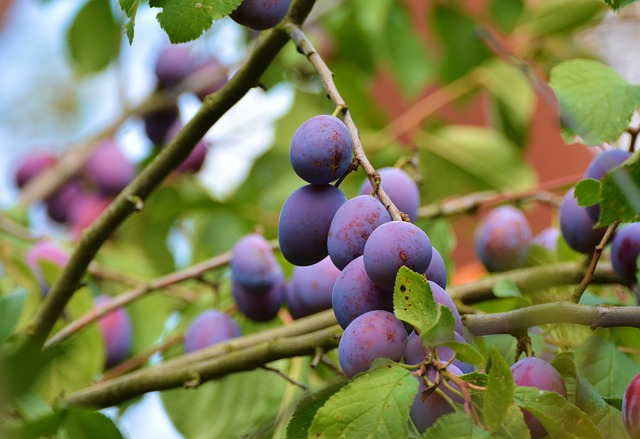
Plum is a summer green tree, 2-6m tall. The plum is a hybrid obtained by crossing an alice and a thorn plum. The color of the trunk is white-grey, cracked, the branches are red, forming an oval crown. The leaves are elliptic, dark green on the top and grayish green on the bottom, arranged alternately, with a toothed edge. The plum blossoms in April-May and the leaves bloom at the same time. The flowers are greenish-white, aromatic, formed by 1-2 on old shoots. The fruits of the plum are flattened and pointed drupes of purple, yellow, green or red color with a bluish coating. The fruits ripen in July-August. The tree is propagated by seeds, lateral shoots, by grafting, rarely by cuttings.
The life span of a plum is related to the variety, it is often able to reach 25 years of age. The tree begins to bloom and produce fruits starting from 8-10 years of life. Early-producing varieties begin to produce fruits starting from 2-3 years of life, late-producing plums begin to produce fruits starting from 7-8 years of life.
Fruits, flowers and leaves of plum are used for medicinal purposes. The healing properties of dried plums are practically identical to fresh ones, so don't be afraid to dry them as well. Plum fruits are harvested in July-August. Only drying equipment is used to obtain quality prunes. The permissible maximum temperature for drying is 50C.
Plum flowers and leaves are collected in spring, until June. The leaves are dried on sieves, in a well-ventilated and shaded place, shaking them from time to time, if you want to dry in forced dryers, then the maximum temperature is also 50C. At the moment when the stalks of the leaves do not bend, but break, the drug can be considered ready. Store in a closed container for up to 1 year.
Plum fruits contain sugar (<11%), dyes (0.06-0.31%), hemicellulose (0.2%), starch (0.1%), fiber (0.5%), pectin (0.9%), organic acids (malic, lemon, Sorrel, salicylic) and tannins. The fruit also contains a lot of vitamins and trace elements: beta-carotene (0.1mg%), tocopherol (0.63mg), vitamin C (10mg), group B vitamins (B1-0.06mg%, B9- 0.08mh%, B6- 0.04mg %, B15- 0.15mg%), PP, K; potassium (214mg%), calcium (28mg%), phosphorus (27mg%), magnesium (17mg%), sodium (18mg%), iron (550mh%), iodine, fluorine, cobalt and chromium.
Up to 40% vegetable fat, amygdalin glycoside, emulsin enzyme have been found in the kernels of the stone. Plum leaves are rich in acylated flavonol glycosides, quercetin, myricetin, myricetin 3-O-4acetyl-L-rhamnopyranoside, esterase, triterpenoids, tannins and galloyl carboxylase.
Medicinal significance
Thanks to research, it has been established that the fruits, leaves, and flowers of the plum have strong pharmacological properties. Plum has antiulcerogenic, antibacterial, radioprotective and antifungal effectiveness. With the help of prunes, the shelf life of meat can be increased, and they also reduce the development of staphylococcus, salmonella and Escherichia coli by up to 90%.
Diarrheal properties of prunes have been known for a long time, but it was scientifically explained only in 2011. Diphenylisatin and sorbitol in plum fruits have also been found to be responsible for this effect.
Dried fruits have a destructive effect on bacteria that cause various diseases of the oral cavity. These substances not only destroy bacteria in the oral cavity, but also prevent gum inflammation, caries and tartar formation.
Dried plums, when compared to other fruits such as plums, quinces, are leaders in terms of antioxidant effect. Antioxidants are those that can protect human cells against damage caused by chemical elements and infections. In addition, the antioxidants in the plum also have a detoxifying effect on heavy metal salts and absorb free radicals. Free radicals are the reason why a person visually ages and develops various degenerative diseases. Prunes will help to cope with hypertension, reducing blood pressure and reducing the risk of stroke. Dried plums are an excellent source of potassium - they ensure an adequate water-salt balance in the body, thus normalizing the functionality of cells, including nerve cells.
US scientific institutes, in studies, determined that dried home plums significantly reduce the risk of intestinal oncology, preventing the development of cancer cells.
Home plums are also widely used in folk medicine. Leaves, flowers, fruits and tree bark are used for medicinal purposes. Plum flowers have gentle laxative properties, regulating intestinal peristalsis. Decoctions of flowers are effective against constipation, colic, nausea, liver diseases, skin dermatosis, furunculosis and neuralgia.
With leaf and flower infusions, kidney and bladder inflammations are treated. A decoction of the leaves acts as a diuretic and softens bowel movements, regulates metabolic processes and can be used to treat stomatitis. Homemade plum leaf tea is useful for people with a sedentary lifestyle. Steamed and fresh leaves are applied externally to treat skin ulcers and wounds.
Homemade plum bark is used to treat malaria, diarrhea and rosacea. Fruit juice has an antibacterial effect on lamblia.
Plum are not only a tasty product, but also a valuable source of potassium, iron and many vitamins. Therefore, doctors often recommend prunes in case of avitaminosis and iron deficiency anemia. Dried plums have a beneficial effect on the functionality of the digestive tract due to the ballast substances it contains. By using 5-6 prunes every day, you will strengthen and heal your body, as well as get rid of a few extra kilograms. By including plums in your menu, you will increase your work capacity, normalize your blood pressure, improve the condition of your skin and the overall condition of your body.
Plum stone cores are also used for medicinal purposes - in case of ascariasis. The fruits of the plum stimulate the appetite, so their juice or dried plum decoctions are given to young children who often refuse to eat. Plum applications can also be applied externally to heal blisters and damaged skin.